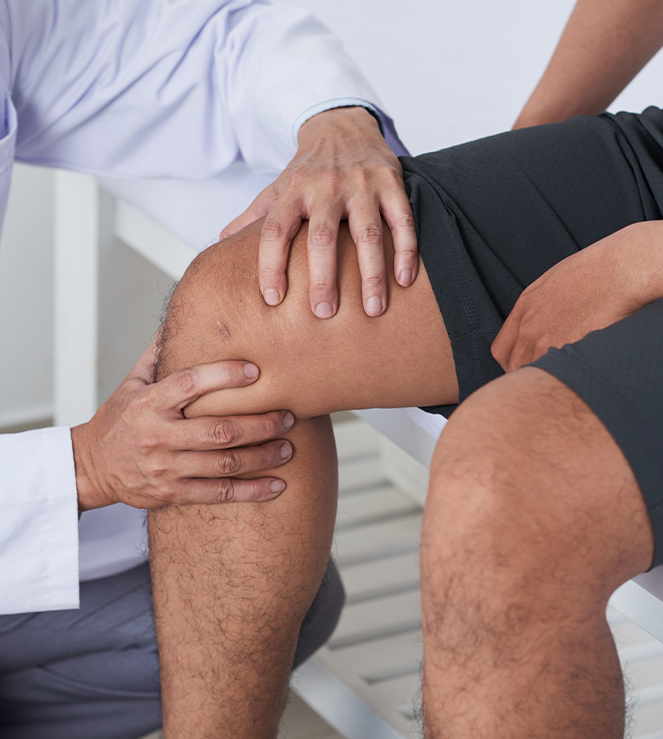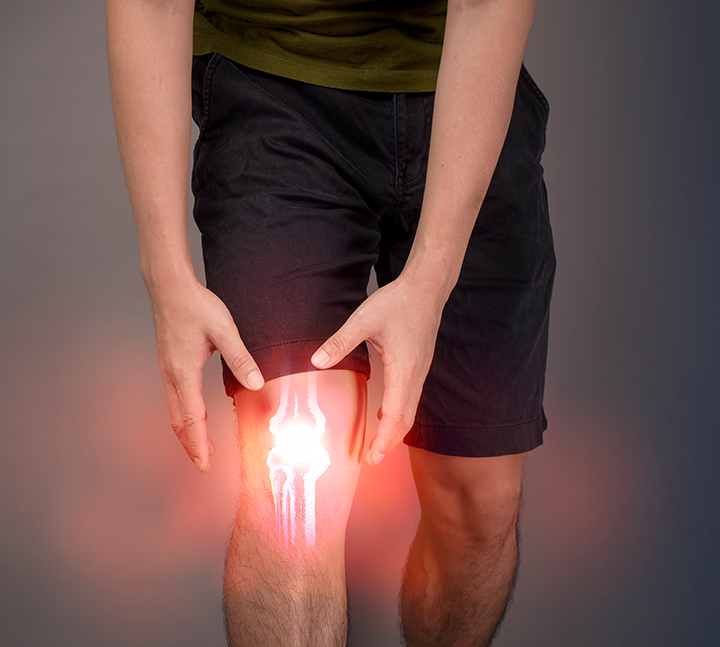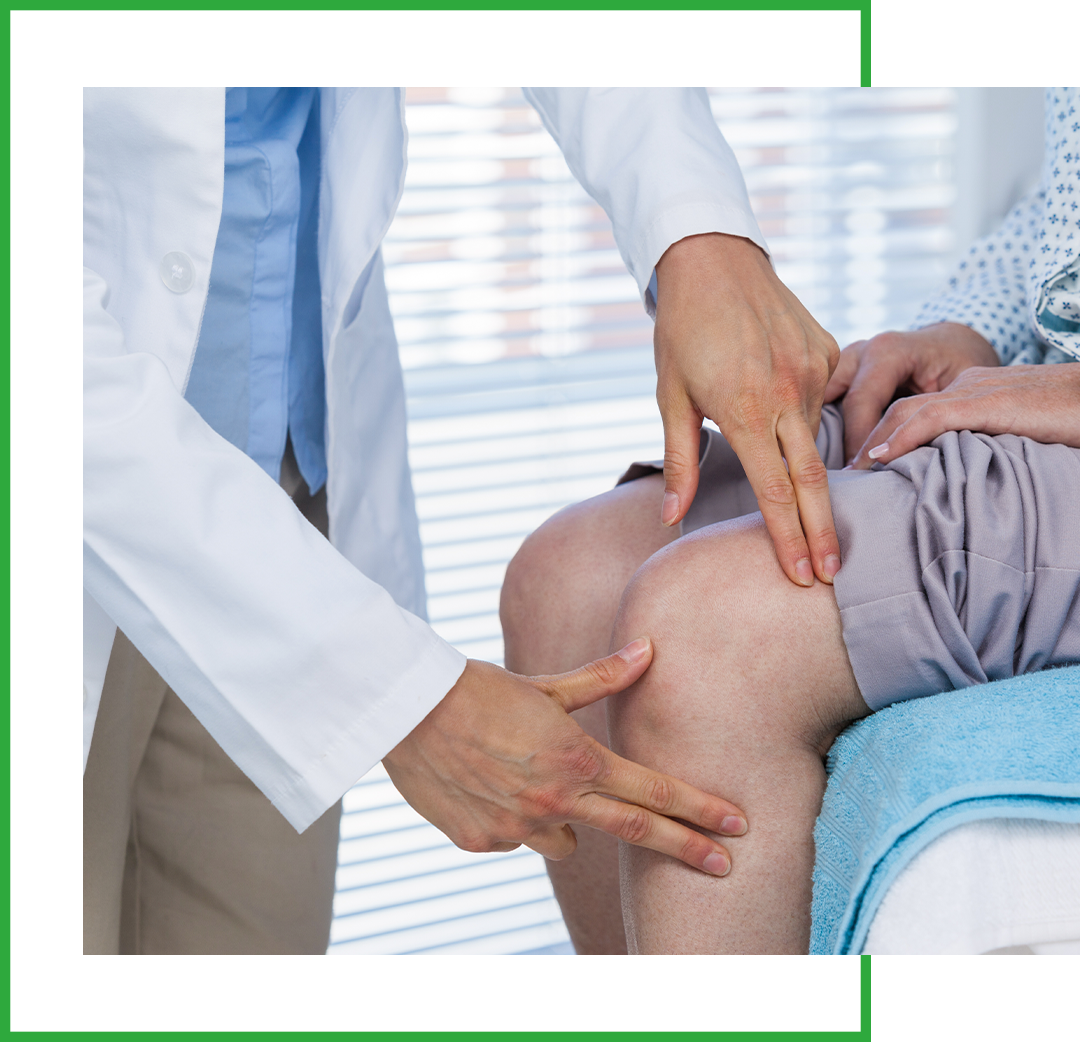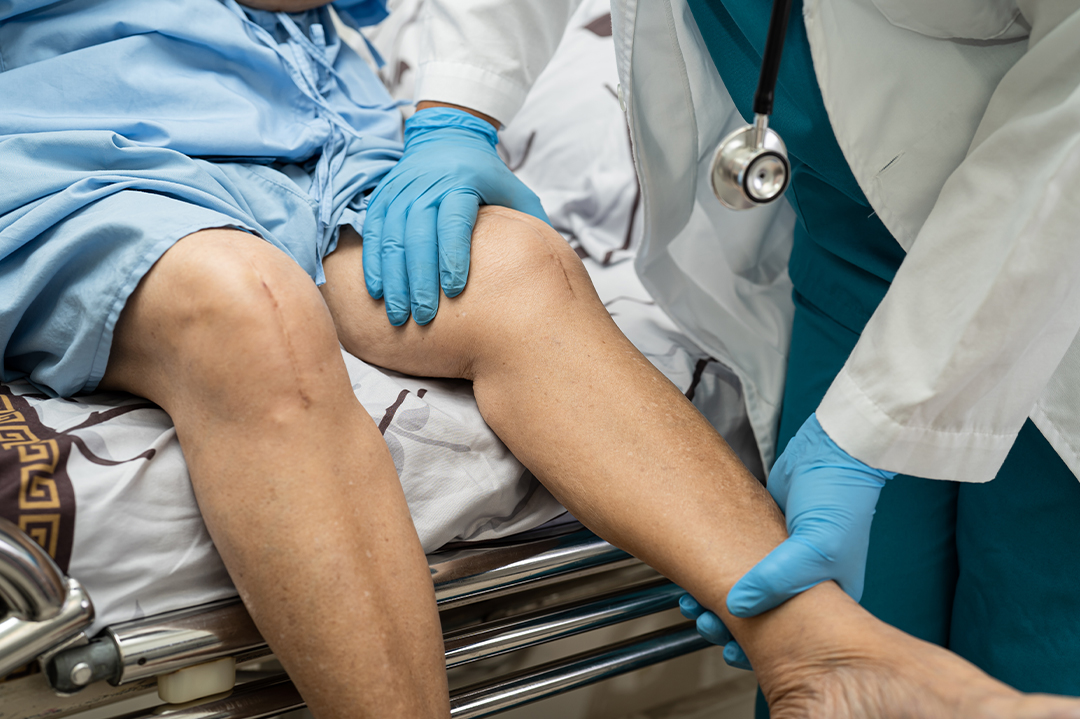
Disconcerting crunching sounds as you walk up hills. Unpredictable swelling that makes it uncomfortable to move. Chronic pains that leave you laid up and reliant on ice packs and pain medications. Knee pain is, without a doubt, one of the most common and painful conditions an adult can go through. It can affect every aspect of your daily life, from picking up the kids from soccer practice to staying on a regular workout routine so you can remain healthy and active.
If you're suffering from knee pain, you're not alone - the American Academy of Family Physicians tells us that almost 25% of all adults in the U.S. suffer from some type of knee pain. In fact, diagnosed knee pain has risen almost 65% over the last couple of decades, adding up to nearly four million visits to primary care doctors annually. That's a lot of chronic knee pain that needs to be addressed.
Unfortunately, many doctors recommend prescription pain pills and invasive surgeries as knee pain treatments instead of non-invasive alternatives. But if you're looking for a way to avoid the need for a knee replacement and pain pills, there's good news to share. QC Kinetix's regenerative medicine in Big Rock, TN, is an all-natural, effective way to help heal prevalent issues like knee arthritis and knee pain without painful surgeries or long recovery times.
Whether you have been fighting through osteoarthritis for years or you've only recently suffered a knee injury, you're probably wondering how regenerative medicine for knee pain works. Regenerative medicine is a revolutionary field of medical science that taps into the body's innate ability to heal and renew itself.
Its main objective is to restore the function and structure of damaged or diseased tissues and organs by either boosting the body's own repair mechanisms or creating new healthy cells to replace the sick ones. For instance, in regenerative ophthalmology, doctors are using retinal progenitor cells to replace damaged retinal cells and combat some causes of blindness.
Regenerative medicine aims to provide a viable alternative to conventional treatments that often involve invasive procedures or long-term medication use. These treatments can cause significant pain and harm to the patient, leading to complications, excessive scarring, and drug dependency. In contrast, regenerative medicine seeks to treat degenerative diseases, injuries, and age-related deterioration by activating the body's natural healing processes and prioritizing the body's inherent capabilities.


Regenerative medicine for knee pain can provide a long list of benefits for men and women who deal with daily pain and discomfort. Some of the symptoms that knee pain can help reduce may include the following:
The benefits of regenerative medicine have been proven through numerous scientific studies and clinical trials. Patients who have undergone regenerative therapies like PRP and stem cell treatment have reported substantial relief from chronic pain, according to a study published in The Journal of Pain Research.
Today, regenerative medicine treatments are being pursued by prestigious institutions like Harvard and the Mayo Clinic. In fact, the National Institute of Health recognizes the field of regenerative medicine as holding great promise for treating and even curing various injuries and diseases.
Regulatory bodies, including the U.S. Food and Drug Administration, maintain strict oversight of regenerative therapies to ensure they adhere to high safety and efficacy standards. Additionally, professional organizations such as the American Association of Tissue Banks (AATB) promote ethical practices and ongoing advancements in the field of regenerative medicine.
The benefits of regenerative therapies for issues like knee pain are both promising and exciting, and can alleviate symptoms without:

The knee joint is made up of bones, ligaments, tendons, and cartilage. Bursae, which are small sacs filled with fluid, help cushion the moving parts of the knee and prevent friction. Knee pain can occur due to various reasons like injury, aging, repeated stress, wear and tear on the joint, or inflammation of the bursa. Knee bursitis is a common condition that causes inflammation of the bursae and leads people to seek knee pain treatments.
Sports activities are a common cause of knee injury as they exert tremendous force on the knee joint. Although the knee can usually handle this stress, it can also cause painful injuries. Some athletes may need knee surgery to repair the damage, while others may delay surgery for years until arthritis develops due to the injury and becomes unbearable. The same goes for average men and women whose minor sprains eventually lead to osteoarthritis and other issues. Fortunately for both parties, regenerative medicine in Big Rock, TN represents a more cost-effective, non-surgical solution for knee pain.

Because of the knee joint's complexity, it is susceptible to a wide range of injuries. Some of the most common knee injuries include the following:

Degeneration and inflammation can impact the knees with chronic and debilitating pain, as seen in osteoarthritis and rheumatoid arthritis. Surgery may be used in severe cases, but for many, finding ways to manage the pain is the only option. However, there is hope in regenerative knee pain therapy, which can provide authentic pain relief, enhance mobility, and lead to a more active lifestyle. Contact QC Kinetix today to learn more about our revolutionary regenerative medicines for knee pain.

Severe pain in the knee may result from the patella ( the kneecap), the connecting thigh bone, or one of the shin bones being fractured. Such fractures are usually caused by abrupt, high-energy impacts like falls from high altitudes or car accidents. The usual treatment for these injuries is to physically reset the broken bone. In some cases, plasma-rich growth factors can be used to help speed up the healing process associated with fractures.

Excessive strain on the knee tendons through activities such as running, jumping, or cycling can result in the tendons becoming inflamed (tendonitis). While rest, ice, knee brace compression, and elevation are commonly used to treat tendonitis, there are other non-surgical and proactive options available for knee pain treatment in Big Rock, TN.

When the bones in the knee shift out of place due to a traumatic fall, twisting of the knee, or high-impact collisions, it causes an injury called dislocation. It is essential to put the dislocated knee back into place, and in severe cases, surgery may be necessary.

Injuries to the knee can result in the tearing of the cartilage or meniscus, which serves as a cushioning pad and shock absorber. Although conventional treatment options are restricted to wearing braces or undergoing surgery, regenerative knee pain therapy can be a promising solution for this type of injury.

When the ligaments or tendons in the knee are overstretched or torn, it can result in a knee sprain or strain. This kind of injury is usually caused by sudden twists and can be quite painful. It often results in swelling and makes it difficult to walk. To help alleviate the pain, it's recommended to apply ice, elevate the knee, and rest. Another option for treatment is regenerative knee pain therapy.
Our non-surgical knee pain treatments can resolve your pain and restore your mobility, so it's worth exploring your options with us. During your Request Appointment, we will assess your current condition and needs with the utmost care and consideration. We understand the impact of pain, and we don't want to prolong your discomfort with ineffective treatments.
If we determine that surgery is the best option for you, we will advise you accordingly to avoid any delays in your recovery. However, if we believe that our regenerative knee pain therapy is a good fit for your needs, we will discuss your options with you in detail.
If you're under the impression that a total knee replacement is the only answer to your knee pain problems, think carefully about these potential downfalls first:

When people experience chronic knee pain, they often turn to knee replacement surgery as a solution. However, there are cases where the surgery can actually exacerbate the pain. Research has revealed that a substantial number of patients experience mild pain after the procedure, while others suffer from pain that is either equal to or more intense than their previous chronic knee pain. In some cases, patients have reported that their pain worsens even years after having undergone knee replacement surgery.

Reports suggest that those who are above 60 years old are at a greater risk of experiencing a heart attack after undergoing surgery. But why? The truth is that the stress and trauma that come with knee replacement surgery can be quite intense, which leads to an increased possibility of heart attacks. If you have heart disease, have had a heart attack, have a history of heart disease in your family, or are over the age of 60, it might be time to consider regenerative medicine.

After undergoing knee replacement surgery, there is a risk of wear particles causing harm to your body. These particles are small fragments of plastic, metal, or ceramic that break off from the replaced joint and can cause irritation to the surrounding tissue. In some cases, wear particles can even enter your bloodstream and lead to metal toxicity or the formation of pseudotumors at a genetic level.

Maintaining strong and healthy knees is essential for everyday activities such as walking, running, standing, or even just getting up from a seated position. Unfortunately, knee pain can significantly impact one's quality of life, making it difficult to perform simple tasks like bathing or dressing oneself.
Furthermore, it can prevent people from participating in enjoyable activities like hiking, biking, or gardening. It can even keep them from getting a good night's rest. Although knee surgery is a painful and extensive process, regenerative knee pain therapies can often provide relief without the need for surgery. These non-surgical treatments are accessible to individuals of all ages and backgrounds who are seeking relief from knee pain.
At QC Kinetix, we offer patients several regenerative medicine options to help treat and ultimately eliminate knee pain symptoms. Some of the most popular therapies our patients choose to help with knee pain like osteoarthritis include the following:

You can think of plasma therapy as preparation for the other regenerative treatments we use to treat knee pain. As part of a non-surgical regeneration plan, plasma contains incredible growth healing factors that can help decrease inflammation in your knees and across your body. Once inflammation goes down, your pain is reduced, and you become more receptive to additional forms of regenerative medicine in Big Rock, TN.

Research indicates that A2M has the ability to alleviate knee pain by disabling particular enzymes that have the potential to deteriorate cartilage cells. When the cells in the cartilage of the knee begin to break down, the bones that combine to form the knee joint are subjected to greater friction during movement, leading to the inflammation of tissues and irritation of nerves.

BMAC is a concentration of regenerative cells obtained from the soft, spongy tissue found in the center of bones, called your marrow. Marrow is often found in areas such as the hips or pelvic bone. These specialized cells can replicate themselves into various types of tissues and promote tissue growth, boosting the body's natural healing abilities to speed up the healing process. By allowing your treatment area to heal naturally and more rapidly, you can find relief from knee pain quickly and more effectively.

In order for the body to heal an injury, it requires blood flow to provide the necessary cells and nutrients. Unfortunately, certain areas within the body have limited blood flow, making it more challenging to heal when injured. This is particularly true when it comes to the meniscus and cartilage in your knees, which have poor blood flow. So, how can you enhance the healing potential of tissues with inadequate blood flow? One option is to utilize PRP, which involves injecting concentrated platelets that contain high volumes of growth factors and proteins. This signals and drives the body's natural healing responses. When used as part of a personalized non-surgical regeneration plan by QC Kinetix, PRP therapy is often an MVP in regenerative medicine treatments.
Many of the physicians and regenerative health providers at QC Kinetix have a background in sports medicine, where they worked with professional athletes to mend broken bones and repair torn ligaments and tendons. It can be incredibly fulfilling to help these individuals recover, but unfortunately, many people - not just athletes - are eager to return to their activities before they have fully healed from surgery. This can be problematic because surgery can often cause more harm than good, leading to a long and painful recovery period.
Regenerative medicine for knee pain takes a different approach by tapping into your body's own healing and repair abilities to address knee pain and damage. During your free consultation, we will assess your current condition and needs and recommend the best course of recovery for your unique body. We prioritize effective treatments and minimizing pain, so if surgery is the best option, we will let you know upfront. However, if our regenerative knee pain therapy is a good match for your needs, we will explain your options in detail, so you can get relief as soon as possible.
If you're sick and tired of your knees holding you back on a daily basis, it's time to reduce your pain and reclaim your mobility. Contact QC Kinetix today to take the first step toward reclaiming your life.
Now Open!After seven months, motorists traveling Big Rock Road no longer have to detour because the new bridge over Pine Creek is now completed.(View photos of old Big Rock Road Bridge at link below)https://www.dropbox.com/sh/xedh0gdzu0lmmu6/AAD4YaS79bSKyY9yy_K9JTmba?dl=0(View photos of new Big Rock Road Bridge at link below)...
Now Open!
After seven months, motorists traveling Big Rock Road no longer have to detour because the new bridge over Pine Creek is now completed.
(View photos of old Big Rock Road Bridge at link below)
https://www.dropbox.com/sh/xedh0gdzu0lmmu6/AAD4YaS79bSKyY9yy_K9JTmba?dl=0
(View photos of new Big Rock Road Bridge at link below)
https://www.dropbox.com/sh/chlivw0pwz6evko/AABH54a_n9ex_17r3waPybrAa?dl=0
Road Supervisor Danny Hale held a ribbon cutting at the bridge Wednesday afternoon accompanied by his secretary Rena Willoughby; the Project Engineer, Kyle Hazel of Hazel Engineering, LLC in Cookeville; and Project Manager Justin Garmany of Dement Construction in Jackson.
Construction began on the new bridge in May and was finished on Tuesday, December 20.
The price tag for the bridge was $1,554,000 but the good news is no local tax dollars were needed to fund it. The state picked up the tab under the state’s IMPROVE Act high priority bridge replacement program.
Although he and his staff did not have to take on the work themselves, Road Supervisor Hale’s involvement was necessary in the planning for the project because the state originally had other ideas.
“Not long after I took office in 2018, they (state) wanted me to spend about $1.1 million to replace a bridge over old Dry Creek Road near Dowelltown but I felt like that was a waste of money because there is no traffic on that portion of Dry Creek Road. Years ago, before I took office, I built an access road through there for then Road Supervisor Kenny Edge, which tied back into Highway 70 from Old Dry Creek Road plus farther down there was another access road, so this bridge really no longer served a purpose. I got with my engineer, and we asked the state to let us redirect the money earmarked for the Dry Creek Road Bridge to the Big Rock Road bridge over Pine Creek because it too was designated by the state as a high priority bridge with an efficiency rating of 51.1% but it has much more traffic on it than the Dry Creek Bridge,” said Road Supervisor Hale.
At first, Hale said the state only wanted to make repairs to the Big Rock Road Bridge instead of an outright replacement, but he convinced them otherwise.
“They (state) had sent me something saying they wanted me to put a new floor in it and rails on it but that was going to cost about $800,000 and it would still have had the old under structure. I couldn’t see doing a patch job when later it would have had to be torn out again with a new under structure put in. It was about two years in the making but they (state) eventually let me swap bridges in the program,” said Hale.
According to Road Supervisor Hale the new two-lane bridge with a weight limit of 40 tons has a state rated life expectancy of 75 to 100 years. The bridge it replaced had a weight limit of eight tons.
Hale praised the project engineer and contractor for their work and cooperation.
“I want to commend them for the timely manner in which the bridge was built and for their craftsmanship. There were no flaws. It didn’t matter when I went over there to check on them, they never needed anything from me. They were always making progress,” said Road Supervisor Hale.
The Tennessee IMPROVE Act of 2017 included a list of 526 local bridges across the state in need of repair. These bridges were identified by the Tennessee Department of Transportation based on bridge inspection reports, which are updated every two years. It is the intent of the Department to address all of these bridges within 14 years. In order to do so, this program was created to prioritize and rehabilitate or replace these local bridges.
Eligible Activities:
The High Priority Bridge Replacement Program (HPBRP), per TCA § 54-4-601, provides funding for priority bridges not located on the State system of highways, known as off-system bridges, for local governments meeting the eligibility requirements in TCA § 54-4-504(c).
“Bridge” means a structure on a public road, including supports, erected for carrying traffic over a depression or an obstruction, such as water or a highway or railway, and having an opening measured along the center of the roadway of more than twenty feet (20′) between under-copings of abutments or spring lines of arches, or extreme ends of openings for multiple boxes; it may also include multiple pipes, where the clear distance between openings is less than half of the smaller contiguous opening. Potentially eligible bridges are prioritized by the Department
Funding: This program can pay up to 100% of the total project cost. It can be used alone or in combination with other bridge programs to rehabilitate or replace offsystem bridges in Tennessee.
1990 State Bridge Grant Program. In order to be eligible for the 100% state HPBRP funding, a county must use at least 33% worth of 1990 State Bridge Grant funds for a bridge on the IMPROVE Act list first. After 33% of a fourteen-year allocation has been committed to a bridge project, the HPBRP can be used to fund the remainder of the project and other bridge projects on the IMPROVE Act list.
GET BACKSTAGE ACCESS Or the closest thing to it. Join our mailing list to be the first to hear about Nashville's new releases, events, announcements and more. Over 180 performance venues form the live music mosaic of Nashville. Multi-genre melodies fill the streets 365 days a year from hallowed stages before crowds of...
| |||
Over 180 performance venues form the live music mosaic of Nashville. Multi-genre melodies fill the streets 365 days a year from hallowed stages before crowds of every size. In Music City you can feel the beat, learn the stories behind the songs, discover your new favorite band or all the above.
Songwriter Venues
The acoustics are optimal at these Nashville landmarks where aspiring and legendary songwriters alike perform hits you know by heart and the best lyrics you’ve never heard.
Explore All Songwriter Music Venues
By Neighborhood and Genre
All Live Music Venues
Whether you listen to rock, country, bluegrass, jazz, hip-hop, folk, or classical music – Music City has it all, every day and every night. Explore Nashville's live music venue by neighborhood or genre.
Honky Tonks
World-class live music plays past midnight under the neon lights of Broadway 365 days a year, so save your cover charge cash for the band (that’s right, no cover charges) and make unforgettable Music City memories.
Live Music & Food
Here in Music City, we know a little about good food and some great live music. Get the night started on a good note at the amazing venues throughout Music City that offer both food and live music.
Muti-Genre Venues
Legends got their start on these world-renowned stages home to multi-genre acts – some equipped with historic wooden church pews and robust acoustics, others shoulder to shoulder standing room only for diehard fans.
Nashville's Musical Attractions
Learn about Nashville’s musical past and present at one of the city’s many music-themed attractions ranging from historic recording studios and backstage tours of world-famous music venues to one of America’s oldest working letterpress shops and even a bus tour serenaded by a local songwriter.
Explore All Musical Attractions
More Music & Entertainment
Browse through more of Nashville's music and entertainment options you need to explore during your trip to Music City.
Searching for the weird heart of a Tennessee roadside attractionIn his 2001 fantasy novel American Gods, the British author Neil Gaiman describes visitors to Rock City—Chattanooga, Tennessee’s most famous non-locomotive attraction—like this: “When they leave, they leave bemused, uncertain of why they came, of what they have seen, of whether they had a good time or not.”When I first read those lines, I bristled—my...
Searching for the weird heart of a Tennessee roadside attraction
In his 2001 fantasy novel American Gods, the British author Neil Gaiman describes visitors to Rock City—Chattanooga, Tennessee’s most famous non-locomotive attraction—like this: “When they leave, they leave bemused, uncertain of why they came, of what they have seen, of whether they had a good time or not.”
When I first read those lines, I bristled—my standard reaction to anyone daring to describe anything relating to my hometown without first living there for eighteen years—then huffed in grudging recognition.
As a kid, I made the pilgrimage up Lookout Mountain to Rock City countless times. With my family, I wandered the narrow paths between boulders and over the suspension bridge to the Lover’s Leap overlook, where I strained to See Seven States and posed for photos with foam-headed mascot Rocky the Elf before descending into the lurid dreamscapes of Fairyland Caverns and Mother Goose Village, a subterranean hallway lined with black-lit dioramas of fairy tales and nursery rhymes. Back then, the place seemed not just entirely natural but eternal to me, without beginning or end. In fact, it had been coaxed into being during the late 1920s by Frieda Carter, an avid horticulturist, lover of European folklore, and wife of a local real estate developer. Frieda designed the trails, augmented the landscape with native plants, and hired a sculptor to build the fairy-tale statuary. Then her husband, Garnet, saw dollar signs. The Carters opened the gardens to the public in 1932 and a few years later paid a man to paint black-and-white ads on barns all the way up to Michigan.
I still mentally salute every see rock city sign I pass along the roadsides of the Southeast—at ease, you weary soldiers of outdoor advertising. A few years ago, I even bought a seen rock city bumper sticker to prove I could lovingly eye-roll like a local despite having lived in Atlanta for a decade. Yet I couldn’t bring myself to slap the sticker on my car. Its claim was true, but I found myself unable to trust my memories of the place. When I poked at them, they squirmed and shifted away. Gaiman’s words buzzed in my head. I knew I’d seen something there, once upon a time, but I could no longer say what it all added up to.
Last August, I used some friends and their tiny kids as an excuse to revisit this childhood mirage and try to get a grip on whatever it was that eluded me. “It is exactly the right amount of cheesy and bizarre, and the views are really beautiful,” I promised. But as we pulled into the parking lot, I got clammy. Naps, feeding schedules, and diaper situations were on the line. If we came out the other side bemused and uncertain—or worse, overtired and hungry and sticky with the sap of a tourist trap—my strange fealty to a handful of gauzy memories would be to blame.
Our posse bought tickets and entered the park through a gift shop stuffed floor to ceiling with birdhouses painted like the famous Rock City barns and lawn gnomes wearing American flag–printed vests. I clenched my teeth. But within moments, we found ourselves walking a trail lined with ferns and rhododendrons cut by nature and time between the mossy walls of hulking sandstone. The humidity dropped precipitously, blessedly. As we navigated one tight passage, my smallest friend, Calvin, strapped to his mother’s chest, rolled back his melon head and grinned at the bright sliver of sky far above.
The path led us through the woods, over and under lichen-flocked footbridges, past assemblages of plaster gnomes working and playing and making moonshine, over an enclosure of fallow deer, all the way to Lover’s Leap with its view of, if not seven states, then at least the rolling green hills and blue haze of Lookout Valley. Rocky the Elf sauntered around the plaza, his old red stocking cap replaced with a jaunty straw boater but his toothless grin as insistent as ever. Kids hugged his knees and grinned for photos, just as I’d done a generation before. My second-smallest friend, Cora, regarded him from a safe distance, her face contorted with repulsion and delight. “I feel you, girl,” I said between mouthfuls of Dippin’ Dots.
We continued down the trail, through Goblins Underpass and Fat Man Squeeze. “So I guess we already went through Fairyland Caverns,” my friend Brooke said after a while, disappointment in her voice. My cackle bounced off the boulders. “No, no,” I said. “You will absolutely know when you’ve gone through Fairyland Caverns.”
And soon enough we were there. A purple-lit stairwell dropped us down, down, down into the earth. Frieda Carter and her sculptor had carved dozens of niches into the rock walls, and each contained a miniature scene from a fairy tale or a nursery rhyme, the figures and sets all painted in colors that pulsed like neon under hidden black lights. Day-Glo Goldilocks ran, in perpetuity, from an oddly muscular trio of Bears; the Three Men in a Tub patiently awaited rescue, knocked back and forth on their same old motorized sea. And around one bend, the route opened wide into a big room with black walls and ceiling receding into infinity, the centerpiece a sprawling landscape: Mother Goose Village. Jack and Jill tumbled along the hill they’d been falling down for decades; vacant-eyed Humpty Dumpty teetered atop his wall, forever on the verge of his own fall; the Dish ran away with the Spoon, and the Cow jumped over the Moon; and Cinderella’s castle glowed above it all, as poised and garish as ever.
My friends kept looking at one another, bug-eyed and laughing. Cora perched on her dad’s hip, mesmerized, the white stars on her pink dress glowing eerie blue. Somehow I’d been that small once, staring from my own parents’ arms at these same strange displays, their oddity barely matching the oddness of my own child mind. All of this had once seemed as natural to me as the boulders and the rhododendrons, and therefore more normal than the whole rest of the world. Here, I realized, was the crux of my confused Rock City memories. Mother Goose Village had once loomed so large in my consciousness that I’d taken to actively downgrading it, overcorrecting for time’s known tendency to inflate and exaggerate. I’d been so certain it would turn out to be small and sad, but it was even bigger and stranger than my original recollections. And it was only here, in the wacky heart of the place, where the air seemed to thin and time to flatten, that I could begin to see what I’d seen here before.
We spilled out of the Caverns laughing and blinking into the sun. “Man oh man,” my friend Austin said, shaking his head. “You really undersold this place. It’s so weird and great.” Cora’s wide eyes were still fixed on the dark hole from which we’d just emerged. In thirty-something years, I wondered, would she return with her own children and her own foggy memories of the place, bracing herself for disappointment and instead finding firm reassurance that you actually can go home again, so long as home is this one particular Depression-era tourist trap? For one dreamy moment, I knew the answer was yes.
I rode the high of my relief all the way to the end of the path, which deposited us back at the gift shop. Among the bric-a-brac emblazoned with the park’s signature demand, I found a Christmas ornament designed to look like one of the Rock City birdhouses designed to look like the Rock City barns. The ideal souvenir for this place—a thing that was and wasn’t a series of even more familiar things. I plucked one from the display, paid for it, and slipped it into my bag on the way to the car, already beginning to forget whatever it was I thought I knew about wherever it was I thought I’d just been. Same as it ever was, same as it should always be.
With the sheer number of things to do outside in Tennesee, the state should be known as nature's playground. You can choose between several hikes from every corner of the Volunteer State with different surprises on each one. This moderate hike in Tennessee has the most impressive rock formations that'll make you think you're in Arizona....
With the sheer number of things to do outside in Tennesee, the state should be known as nature's playground. You can choose between several hikes from every corner of the Volunteer State with different surprises on each one. This moderate hike in Tennessee has the most impressive rock formations that'll make you think you're in Arizona.
Gain access to limited free articles, our daily newsletter, news alerts and more.
Twin Arches Trail is located within the tiny town of Oneida, Tennessee, and it's sporting some serious feats of nature.
You can opt to take the shorter version of the trail that's only 1.4 miles roundtrip. At the 0.7-mile mark, you come across one of the most memorable features of the hike, Twin Arches.
The Twin Arches are as the name implies - two sandstone structures that are basically fraternal twins. The North Arch is 62-feet high, while the South Arch is 103-feet high. You'll feel like an ant when you stand and look up at either arch.
Twin Arches Loop Trail is the longer version of the hike at 4.6 miles roundtrip. With the length and number of steep staircases you have to clear, the hike has been ranked as moderate. Along the way, you encounter old rock shelters used by Native Americans, miners and early settlers.
Your journey will take you above, below, and even in some of the little caves that nature has created. No matter how long you spend on the trail, you're guaranteed to see some eye-catching land and water features.
The hike on the way to the arches features lush, full forests that are a bear haven. Several hikers have spotted black bears along the route, so know what to do if or when you see one of the forest's most misunderstood creatures.
For Tennesee explorers looking to explore more of the earth's art, this cave and hidden lake offer up some more unbelievable views.
Price: Free
Address: 4564 Leatherwood Road, Oneida, TN 37841
Why You Need To Go: The giant rock formations here resemble the larger than life structures in Arizona.
At least two dozen tornadoes moved through Southern and Midwest states late Friday into early Saturday, leaving death and destruction in their wake.Early reports indicate the storms were historic events in several states including Tennessee and Kentucky.The unstable weather moved east as a cold front confronted warm moisture from the south over Tennessee, Arkansas, Missouri, Indiana, Illin...
At least two dozen tornadoes moved through Southern and Midwest states late Friday into early Saturday, leaving death and destruction in their wake.
Early reports indicate the storms were historic events in several states including Tennessee and Kentucky.
The unstable weather moved east as a cold front confronted warm moisture from the south over Tennessee, Arkansas, Missouri, Indiana, Illinois and other areas as far as Arizona.
Kentucky Gov. Andy Beshear declared a state of emergency and sent a letter to President Joe Biden just before dawn seeking federal recovery funds.
MONDAY UPDATES:Middle TN continues recovery after at least seven tornadoes touched down
"One tornado struck the city of Mayfield which is reporting major damages to public facilities, businesses and residences," Beshear wrote. "A Graves County factory has collapsed, trapping workers, and we believe there are at least 50 fatalities."
A candle factory in Mayfield was destroyed while 110 people were inside, he said, adding that he expects the death toll to rise.
Three deaths were reported in northwest Tennessee's Lake County and a third in nearby Obion County as the storm blew east before heading north at the Tennessee River, according to the Tennessee Emergency Management Agency.
A fifth person remains missing in Lake County.
Wind gusts reached 78 mph at Nashville International Airport at 3:30 a.m. – the third-highest ever recorded, the National Weather Service said.
At least 118 power poles were found broken or destroyed Saturday by Nashville Electric Service, which bears the brunt of the state's ongoing power outages with about 30,000 residences without electricity.
Jennifer Davis-Kelley, 46, and her husband Brian Kelley assessed damage at their home on Lance Way with dozens of Willoughby Station residents in Mt. Juliet Saturday morning.
"It sounded like a train. It sounded like the roof was lifting up, like something was sucking it up," Davis-Kelley said.
Weather updates:Tornadoes, high winds move through Middle Tennessee overnight
Special report:Tornadoes are hitting more frequently and dealing more deaths in the South
One person died in an Arkansas nursing home when the building was flattened.
An Amazon distribution center collapsed in Edwardsville, Ill., killing two people, according to early reports.
In Middle Tennessee, weather officials reported several tornadoes measured on radio-wave radar trackers.
Stewart County, Dickson County and Mount Juliet readings showed tornado-like conditions. National Weather Service survey teams deployed Saturday to assess whether true tornadoes had formed.
An EF-2 tornado with winds higher than 111 mph struck Dickson, NWS surveyors reported Saturday evening.
"We definitely had a number of potential tornadoes go across West and Middle Tennessee," said NWS meteorologist Matt Reagan. "This is a slow process, especially when it's so many areas. We have to take it one damage tract at a time."
In South Nashville, a roof collapsed at Ashton Apartments and a power line sagged near the ground at Bell Road and Nolensville Pike. Large trees fell at Nashville National Cemetery in Madison, damaging several headstones, and nearby traffic lights were dark.
Widespread damages included downed power lines, damaged signs and structures and fallen trees from Big Rock to Kingston Springs.
More than 132,000 power outages were reported in West Tennessee, with nearly 90,000 of those in Davidson County on Saturday morning reduced to 50,000 by 3:15 p.m. as they were working to repair major infrastructure.
Six Nashville Fire Department stations were without power at 8 a.m. but officials said it was not affecting service.
Nashville Electric Service updated customers online about power restorations.
"NES crews are working to restore power to the area after this morning’s devastating storms," Nashville Electric Service said in a statement. "It may take time to restore every outage since they are so widespread across the service area. We assure customers that crews will work as quickly as possible to safely restore power and will not stop until every customer has power."
Dozens of homes were badly hit on Murrell Road in Dickson County. Fallen trees and power lines were found throughout the region.
"Murrell Road is ground zero," said Dickson County Emergency Management Agency Director Rob Fisher. "It’s destroyed down there.
"It will be days to clear all this. We are probably looking at 25-plus homes with heavy damage. Upwards of four of them are totally destroyed."
Displaced families were taken to the Dickson County Family YMCA, which was operating a storm shelter.
Follow storm:Nashville weather radar
Up to 80 homes were also affected in Mt. Juliet, with about a dozen receiving significant damage.
"Glass started breaking as we tried to get everyone downstairs," said Julian Mitchell, whose 15-year-old son had to be treated because of a laceration.
Severe weather trends:'Tornado Alley' is expanding: Southern states see more twisters now than ever before
Gov. Bill Lee visited damaged communities in West Tennessee Saturday afternoon.
"We are working with TEMA and first responders to evaluate the impacts of severe overnight storms and are deploying resources to immediately assist communities," the governor posted on Twitter. "Maria and I pray for families, including our neighbors in Kentucky, who are facing loss of life and devastation today."
President Joe Biden was also briefed on the storms across the central United States. He spoke with Lee and the governors of Kentucky, Arkansas, Illinois and Missouri. He asked them to call him directly if they are in need of federal support and said he would deliver assistance through FEMA as quickly as possible.
"To lose a loved one in a storm like this is an unimaginable tragedy," Biden posted on Twitter. "We’re working with governors to ensure they have what they need as the search for survivors and damage assessments continue."
Sandy Mazza can be reached via email at smazza@tennessean.com, by calling 615-726-5962, or on Twitter @SandyMazza.
